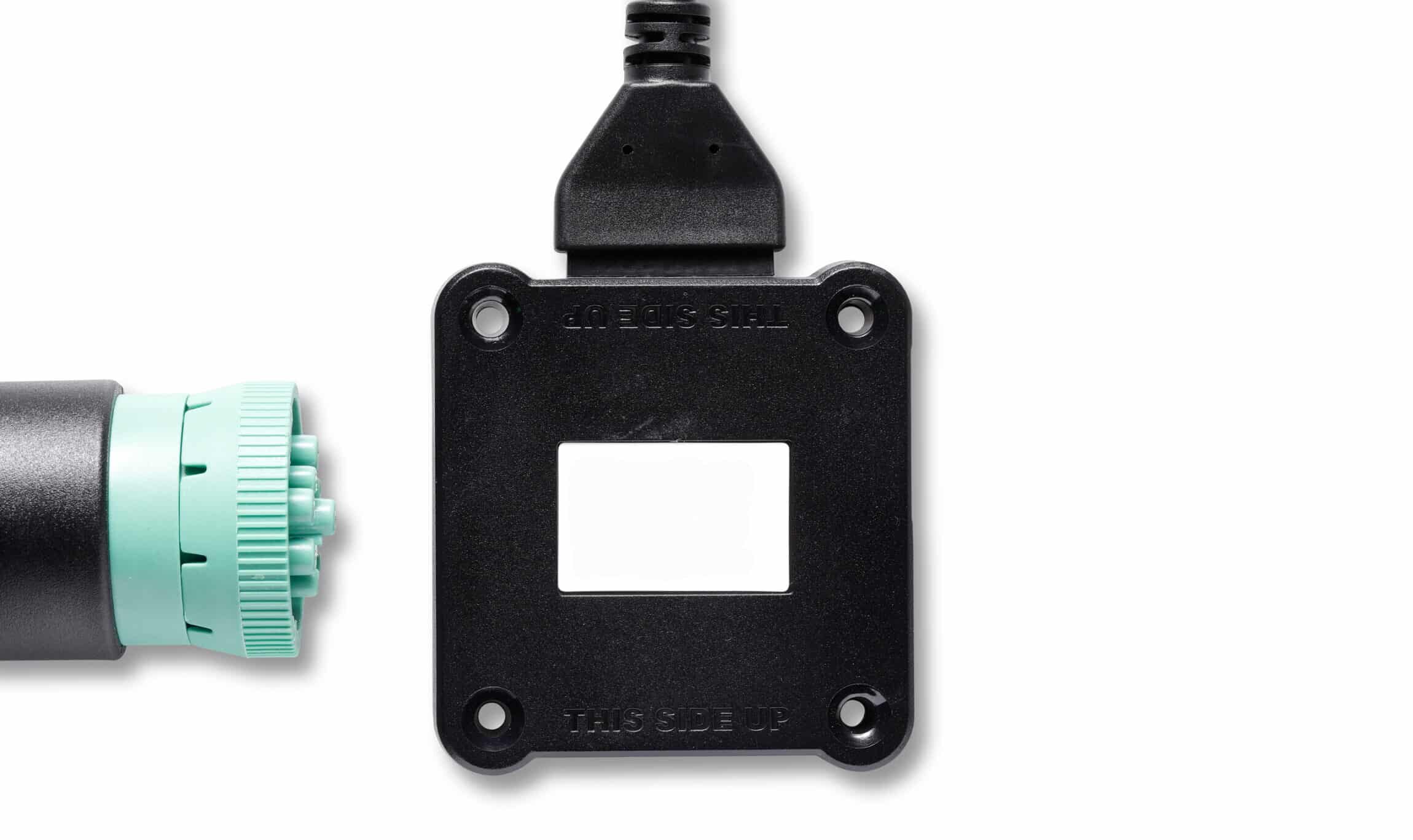California’s ELD mandate for intrastate drivers took effect on January 1, 2024, requiring electronic logging devices for drivers who previously used paper logs. This new rule brought California-based truckers in line with federal standards that most interstate drivers have followed since 2019. The mandate impacts a large portion of California’s trucking workforce. For drivers who relied on paper logs for years, this change meant learning new technology while avoiding expensive violations.
This guide covers everything about the ELD law in California. We’ll explain the rules, who needs to comply, what exemptions exist, and how to avoid common violations. You’ll learn the differences between California and federal requirements, plus how to choose the right ELD for your operation. We’ll also show how modern solutions like HOS247 make compliance easier while adding features to help your business run smoother.
Do you have any questions? Talk to ELD Advisor: 650-405-3372 or Request Callback
Understanding California’s ELD Law Requirements
California’s ELD law has required intrastate commercial drivers to use electronic logging devices since January 2024, bringing them in line with interstate drivers who have followed federal ELD requirements since December 2019. After nearly two years of enforcement, the California Highway Patrol (CHP) has established clear compliance expectations with no tolerance for violations.
Who Must Use ELDs
Is ELD mandatory in California? It is if you drive a commercial motor vehicle and are required to keep records of duty status (RODS). This includes:
- Drivers of vehicles weighing more than 26,000 pounds.
- Drivers transporting hazardous materials requiring placards.
- Passenger carriers with vehicles designed for 16 or more people.
Interstate vs. Intrastate Operations
The type of commerce you operate determines which ELD regulations apply to your business:
- Interstate drivers follow federal ELD rules, which apply when you cross state lines or transport freight that originated in or is destined for another state.
- Intrastate drivers operating only within California follow state ELD requirements. California ELD rules mostly align with the Federal Motor Carrier Safety Administration’s (FMCSA’s) existing mandate, but with some differences, which we will cover later in this article.
- Mixed operations (drivers who do both interstate and intrastate) must use ELDs that meet federal requirements at all times.
Current Enforcement
The California Highway Patrol conducts regular roadside inspections and compliance checks. After nearly two years of enforcement, officers expect immediate compliance. Common violations include:
- Operating without a required ELD.
- Using non-compliant devices.
- Failing to maintain proper logs in the system.
The law creates consistent logging standards across California’s commercial driving industry while supporting road safety through accurate hours of service tracking.

ELD Exemptions in California
Not every commercial driver in California needs an ELD. The state recognizes several exemptions that match federal guidelines, allowing certain drivers to continue using paper logs or no logs at all.
Vehicle Age Exemption
- Pre-2000 vehicles. CMVs manufactured before model year 2000 don’t need ELDs because older engines lack the electronic control modules required for ELD connection.
- Engine replacements. Vehicles from 2000 or newer with pre-2000 engine replacements also qualify for the exemption.
- Documentation needed. Keep registration and engine documentation handy to prove your exemption during inspections.
Limited Use Exemption
The limited use exemption helps occasional commercial drivers avoid ELD expenses. If you don’t operate a CMV more than 8 days in any 30-day period, you can use paper logs for those limited days. This exemption works well for farmers during harvest season or businesses that occasionally need commercial vehicles. Track your driving days carefully—going over the 8-day limit even once requires immediate ELD installation.
Driveaway-Towaway Operations
Some operation types don’t require ELDs regardless of frequency. Driveaway-towaway operations where the vehicle being driven is the commodity qualify for exemption. This includes delivering new trucks from manufacturers or moving vehicles between dealerships. Drivers transporting empty vehicles or unladen trailers also qualify, as long as the empty vehicle is the primary reason for the trip.
Short-Haul Operations
Short-haul operations get special consideration under California law. If your business operates exclusively within a 100-air-mile radius and releases drivers within 12 hours, you don’t need ELDs. Instead, you can use time cards or timesheets to track hours. Remember that this only applies to true local operations — one trip beyond the radius or one shift over 12 hours eliminates the exemption for that driver.
Businesses conducting purely intrastate commerce may qualify for the short-haul exemption if they meet all requirements. This includes local construction companies, aggregate haulers, and utility service vehicles that work within defined local areas. Document your operations carefully to prove exemption eligibility if questioned.
Important Reminders
Drivers claiming exemptions should carry documentation proving their eligibility. This might include vehicle registration showing the model year, company timesheets showing short-haul operations, or bills of lading proving driveaway-towaway status. Having proper paperwork ready speeds up inspections and prevents misunderstandings about your exempt status.
Even with an exemption, you must still follow all applicable hours of service rules and maintain required records — the exemption only covers the ELD requirement itself.
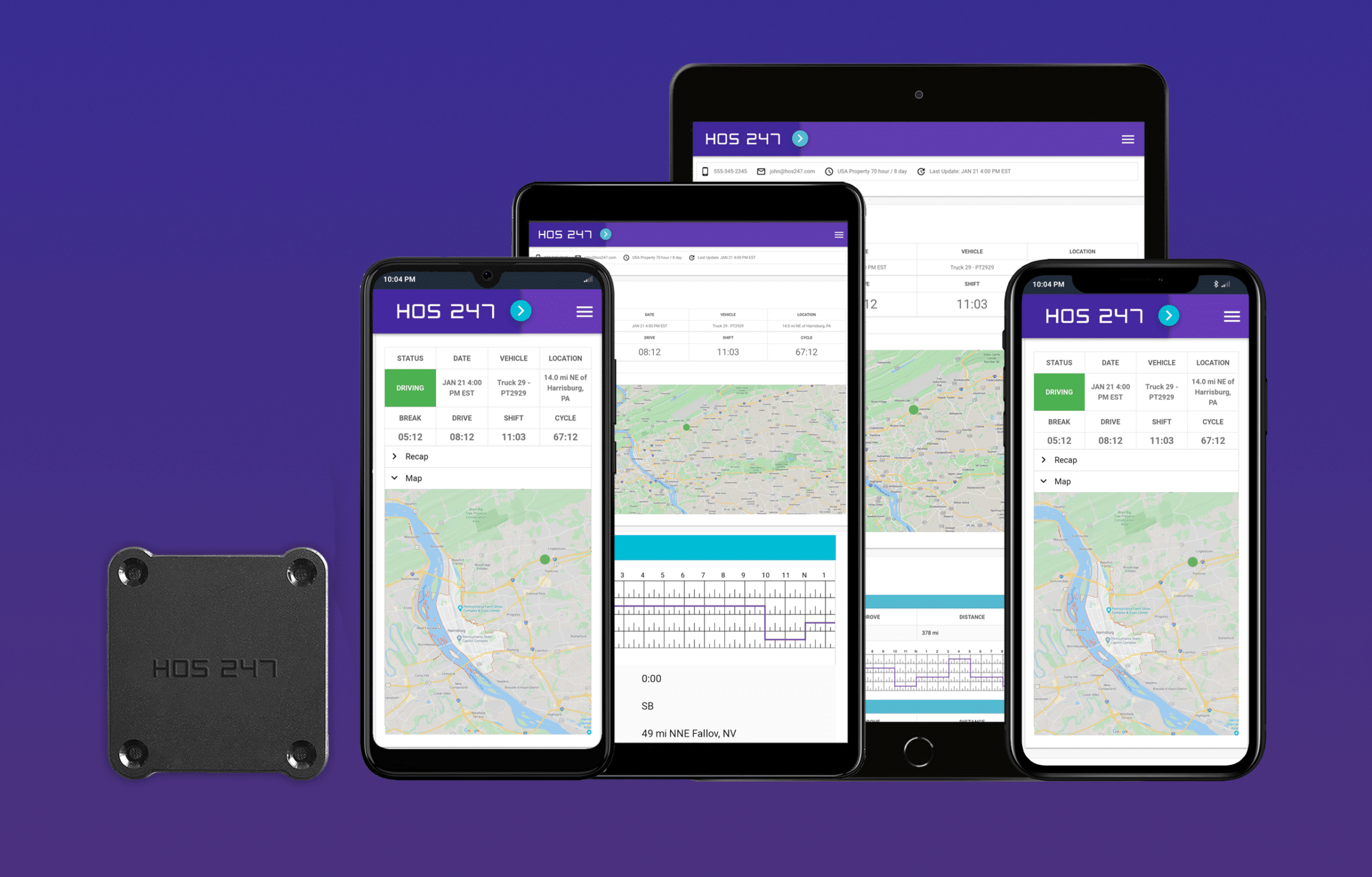
Federal vs. California ELD Laws: Key Differences
While California’s ELD mandate aligns with federal regulations in many ways, several important differences affect how intrastate drivers operate. Understanding these distinctions helps you stay compliant whether you’re driving locally or crossing state lines.
Short-Haul Exemption Differences
As covered in the exemptions section, California’s short-haul rules are stricter than federal requirements — 100 air miles and 12 hours versus the federal 150 air miles and 14 hours.
Rest Break Requirements
California drivers don’t need to take the 30-minute rest break required under federal rules. This means intrastate drivers can work their full shift without stopping for a mandatory break, though many companies still encourage regular rest periods for safety. However, if you ever drive interstate, you must follow federal rules including the 30-minute break requirement.
Hours of Service Flexibility
California intrastate drivers have additional flexibility in their driving hours. While federal rules allow 11 hours of driving within a 14-hour window, California drivers can drive up to 12 hours within a 16-hour on-duty period. This extra flexibility applies only to purely intrastate operations.
Data Transfer Requirements
When it comes to roadside inspections, California only accepts the telematic method for ELD data transfer. This means your ELD must be able to send data electronically through web services or email. The bluetooth option that federal inspectors accept won’t work for California Highway Patrol inspections. Make sure your ELD supports telematic transfer before purchasing, or you could face violations even with an otherwise compliant device.
What Hasn’t Changed
It’s crucial to remember that California’s mandate doesn’t change hours of service rules — it only changes how you record them. You still follow the same driving limits, on-duty time, and required off-duty periods. The ELD simply replaces paper logs for tracking these hours electronically. This distinction matters because some drivers mistakenly think the ELD mandate introduced new driving restrictions.
Best Practice for Mixed Operations
For drivers who switch between intrastate and interstate operations, following federal rules all the time is the safest approach. Federal requirements are generally stricter, so compliance with federal standards automatically meets California requirements. This prevents confusion and violations when your driving patterns change from week to week.
Common ELD Violations and Penalties in California
ELD requirements in California are enforced strictly, and violations can result in significant financial penalties and operational disruptions. Knowing what inspectors look for helps you avoid expensive mistakes that can hurt your business.
Financial Penalties
ELD violation penalties can vary significantly based on the specific type and severity of the violation. Effective January 1, 2024, log book violations can range from $1,496 to $14,960 per driver for errors or falsifications in logbooks. For non-record keeping violations, penalties may reach up to $18,170 per violation. ELD violations result in a maximum civil penalty of $1,307 for each day the violation continues, up to $13,072. Each issue gets its own fine, so one bad inspection can result in thousands of dollars in penalties.
Most Common Violation Causes
The most common violations happen because drivers aren’t prepared, not because they’re trying to cheat. Here’s what catches drivers off guard:
- Data transfer problems. California only accepts the telematic method of transfer – if an officer wants to see your logs and you can’t send them electronically using the approved method, that’s a violation.
- Missing documentation. Not having your elog instruction card, user manual, or blank paper logs with you results in citations.
- Equipment failures. The driver has been operating a vehicle with a malfunctioning ELD for more than 8 days violates regulations.
- Device visibility issues. The ELD can’t be viewed by roadside enforcement from outside the vehicle is another common violation.
Out-of-Service Orders
If a non-exempt driver doesn’t have an electronic logbook when required, they’re also placed out of service for at least 10 hours. Your truck stays parked until you fix the problem, which may require emergency ELD installation or repairs. Drivers will be placed out-of-service in accordance with the Commercial Vehicle Safety Alliance (CVSA) OOS Criteria.
Beyond the Fines
These violations affect more than just immediate costs. Each day is an estimated loss of $264 in revenue when a driver is out of service. Additionally, when a driver gets an out-of-service order, the vehicle will likely have to be towed. Your CSA scores are also impacted, which can affect insurance rates and business opportunities. For owner-operators working on tight margins, violations can significantly impact profitability.
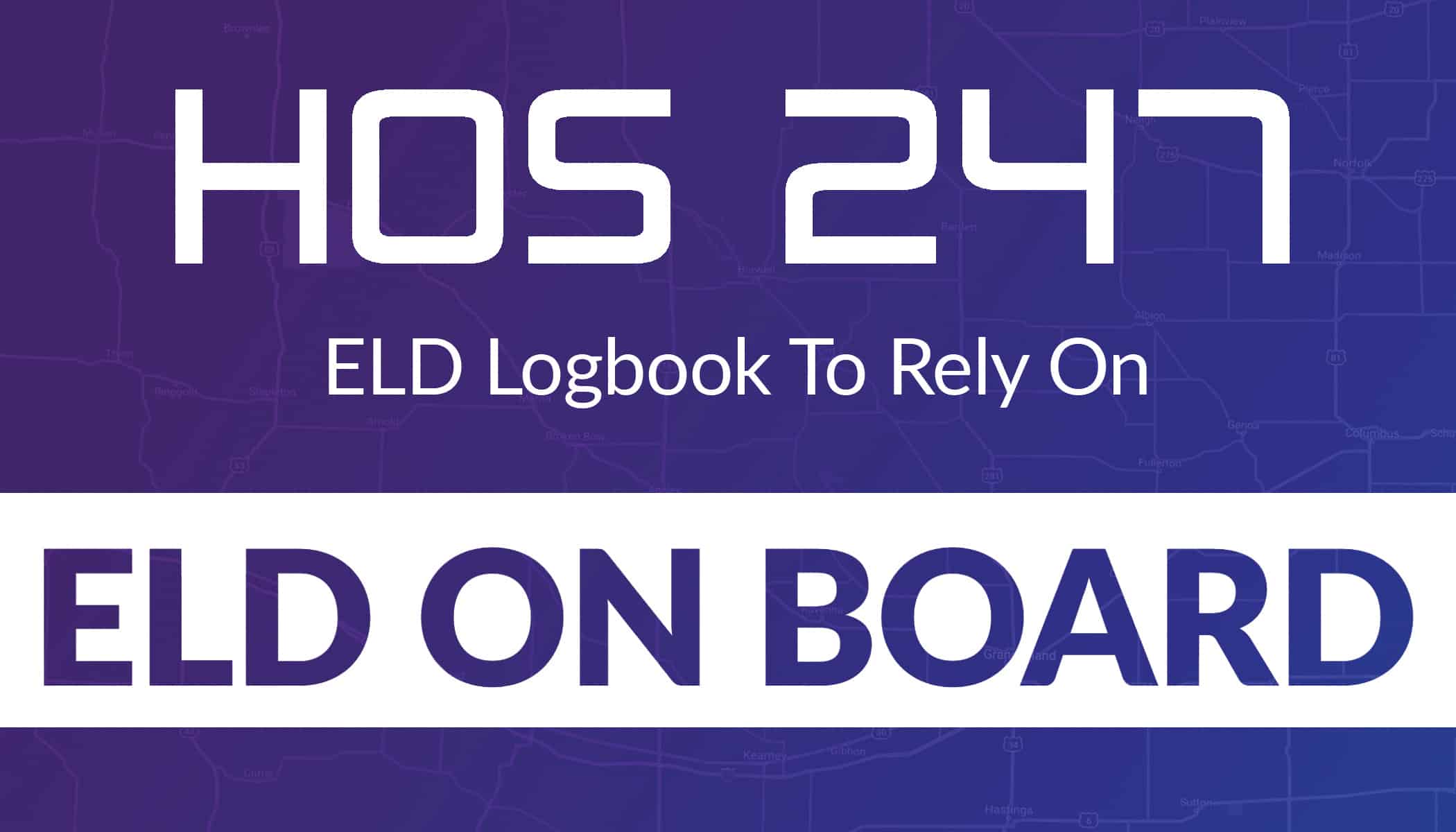
HOS247 ELD Solution for California Compliance
HOS247 offers an ELD system built for truckers who want simple, reliable compliance without the hassle. The system helps you follow California’s rules while making your daily operations easier. Here’s what makes HOS247 work for California truckers:
- Easy to use. Simple screens and clear buttons mean less training time and fewer mistakes.
- Multiple languages. Get help in English, Spanish, Russian, or Polish, seven days a week.
- No contracts. Pay month-to-month or yearly — you’re not locked into long agreements.
- Try before buying. Test everything free for two weeks to make sure it fits your needs.
- Stays current. Software updates automatically when rules change in California or federally.
- Built tough. Hardware that installs fast and keeps working mile after mile.
- One-year warranty. Free replacement for defective devices gives you peace of mind.
- Automatic compliance. System prevents violations with real-time alerts and automatic hour calculations.
- Reliable support. If your call drops, they call you back. Support runs seven days a week.
- Simple setup. Plugs into your diagnostic port and connects to your phone in minutes.
- Works with your devices. Compatible with smartphones and tablets you already have.
- Fleet management ready. Managers can monitor all drivers from one account in real time.
Beyond Basic Compliance
HOS247 does more than just track hours. GPS fleet tracking shows where your trucks are at any moment. It also tracks your miles by state automatically for IFTA reporting, saving hours of paperwork each quarter. These features turn a government requirement into a tool that actually helps your business.
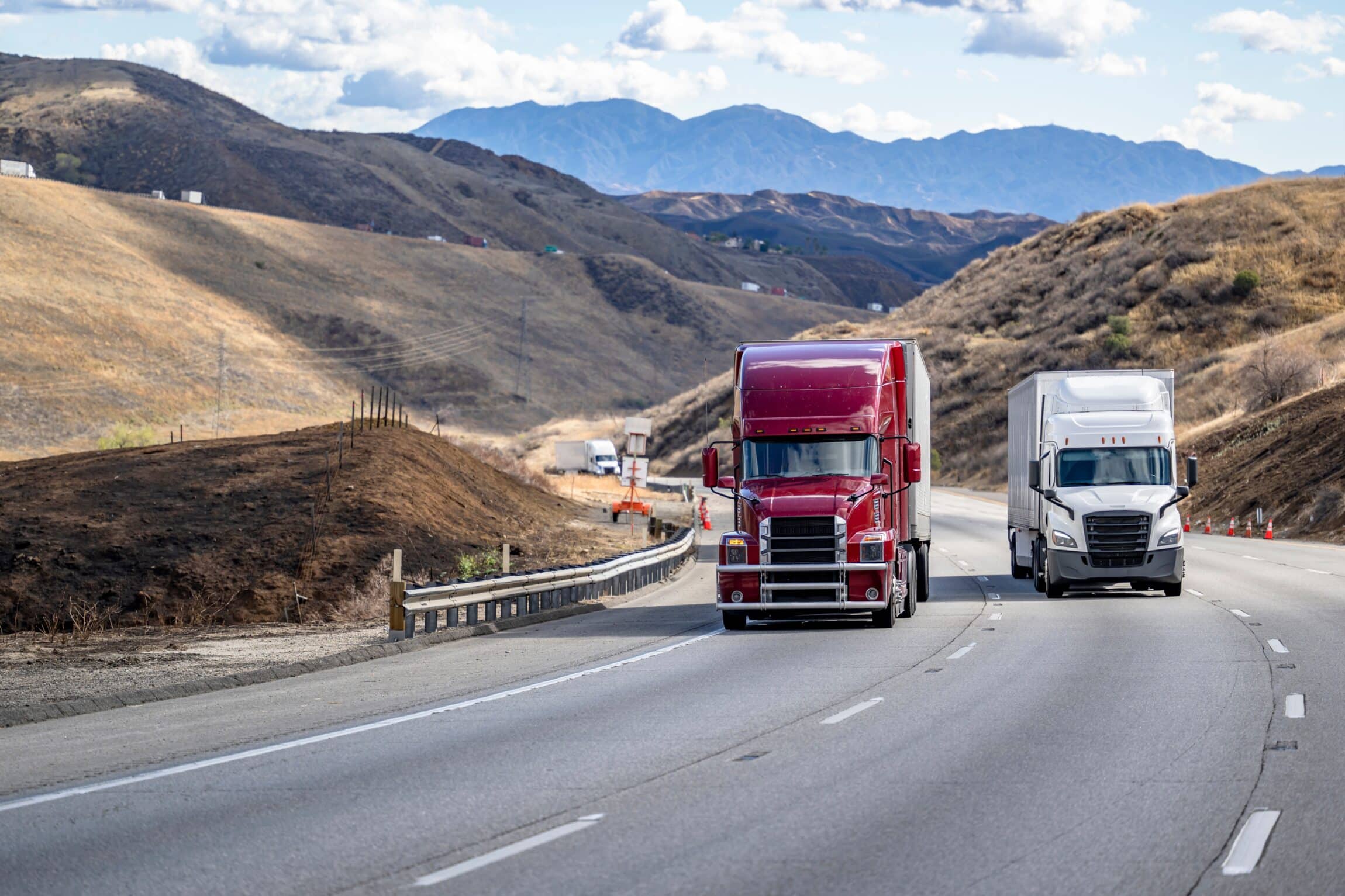
How to Choose the Right ELD for California Operations
Picking the right ELD means looking beyond just meeting basic requirements. The device you choose affects your daily operations, your budget, and your ability to avoid violations. We have compiled a list of features to look for:
- FMCSA approval. Only buy devices on the FMCSA’s registered list — uncertified ELDs can get you violations.
- Telematic data transfer. California requires electronic transmission, so make sure your ELD supports this method.
- GPS tracking capabilities. Real-time location helps with dispatch, customer updates, and route planning.
- Automatic IFTA reporting. Saves hours calculating state miles and reduces errors in fuel tax filing.
- Multiple language options. Important if you have drivers more comfortable in Spanish or other languages.
- Strong connectivity. Reliable performance in remote areas where cell service might be weak.
- Easy-to-use interface. Simple screens reduce training time and prevent costly log errors.
- User-friendly DOT inspection mode. Quick access to logs during roadside inspections speeds up the process.
- DVIR functionality. Electronic vehicle inspection reports replace paper forms and save time.
- Fleet management tools. Features for tracking maintenance, fuel use, and driver performance.
- Integration options. Ability to connect with dispatch, accounting, or other business software.
- Hardware durability. Devices built to handle vibration, temperature changes, and daily use.
- Flexible pricing. Month-to-month or annual plans without long-term contract requirements.
- Customer support availability. Real person help when you need it, not just automated responses.
- Training resources. Clear instructions and support materials for getting drivers up to speed.
- Mobile app compatibility. Works with devices you already own or provides dedicated hardware.
- Data backup. Automatic saving of logs to prevent loss during device failures.
Taking time to evaluate these features before buying saves money and headaches later. The cheapest ELD isn’t always the best value if it lacks important features or reliable support.
Implementing and Optimizing Your ELD System
Whether you’re installing your first ELD or switching to a better provider, proper implementation ensures smooth operations and compliance from day one.
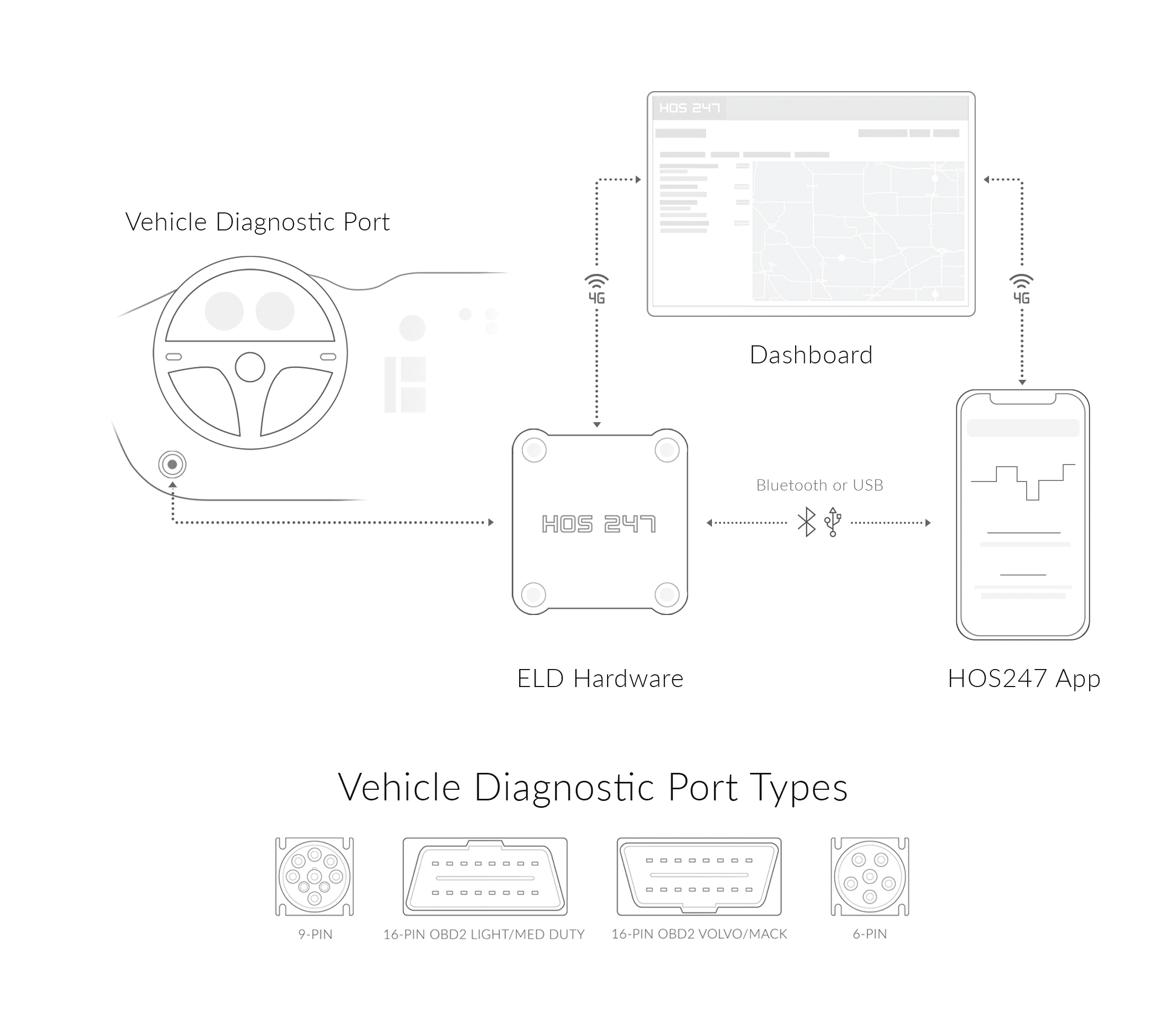
Step-by-Step Installation Process
Physical installation takes about 15 minutes, but proper setup requires attention to detail:
- Locate the diagnostic port. Find the 9-pin or 6-pin circular port (heavy-duty trucks) or OBDII port (light/medium-duty vehicles), usually under the dashboard near the steering column.
- Install the device. Plug the cable into the diagnostic port and secure the ELD unit on your dashboard using the provided mount. Position it where you can see alerts without blocking your view of the road.
- Set up the app. Download your provider’s logbook app on your smartphone or tablet. Create your driver profile with your license number, employee ID, and contact information.
- Connect and verify. Pair the app with your ELD device via Bluetooth or USB cable. Check that the green connection indicator appears and verify the system is reading engine data, GPS location, and vehicle identification correctly.
- Test all functions. Practice logging in, changing duty status from off-duty to driving, adding location notes, and accessing the DOT inspection screen. Send a test log transmission to confirm electronic data transfer works.
Driver Training Essentials
Dedicate at least 2 hours for hands-on training with each driver. Cover these critical tasks:
- Daily login procedure. Enter credentials and select the correct vehicle from your fleet list
- Status changes. How to switch between driving, on-duty, off-duty, and sleeper berth
- Adding annotations. Include required notes for pre-trip inspections, fuel stops, and breaks
- DOT inspection mode. Practice accessing and transmitting logs during mock roadside stops
- Malfunction procedures. What to do when devices fail and how to switch to paper logs within 24 hours
Switching ELD Providers Successfully
Changing systems requires careful coordination to avoid compliance gaps:
- Download historical logs 30 days before switching. Export all data for the past 6 months as required by law
- Schedule installation during downtime. Avoid switching devices mid-trip to prevent compliance gaps
- Prepare backup documentation. Have paper logbooks ready in case of technical issues during transition
- Test new system thoroughly. Verify all features work correctly before removing old devices
- Notify dispatch and safety teams. Ensure everyone knows about new login procedures and portal access
Common Implementation Challenges and Solutions
These issues arise frequently during the first few weeks of ELD use:
- Vehicle mis-selection. Create a vehicle selection checklist and require drivers to verify truck number, VIN, and license plate before starting trips.
- Missed status changes. Set automatic reminders every 15 minutes when stopped to prompt duty status updates.
- Poor connectivity in remote areas. Identify dead zones on regular routes and train drivers to manually log when signal returns.
- Multi-driver vehicles. Establish a clear handoff procedure requiring complete logout, vehicle inspection verification, and new driver login confirmation.
- Unassigned driving events. Review unidentified driving within 24 hours and assign to the correct driver with location and time verification.
Maximizing Your ELD Investment
Transform compliance data into operational improvements with regular monitoring:
- Daily log reviews. Check for errors, missing information, and potential violations every morning before dispatch.
- Weekly data analysis. Use reports to identify fuel waste, excessive idling, and route optimization opportunities.
- Monthly compliance audits. Review violation trends, driver performance, and system accuracy with your safety team.
- Quarterly training refreshers. Update drivers on new features, regulation changes, and best practices.
Performance Monitoring and Optimization
Track these key metrics monthly to measure ELD system effectiveness:
- Violation rates per driver.
- Average daily utilization hours.
- Fuel efficiency improvements.
- Customer delivery performance.
- Inspection pass rates.
Starting with a detailed implementation plan and ongoing optimization makes the difference between ELDs being a compliance burden or a valuable business tool. Invest time upfront in proper setup and training to avoid costly violations and operational disruptions later.
Long-Term Benefits of ELD Compliance
While ELDs might seem like just another regulation, they actually deliver real benefits that improve your business over time. Smart truckers use these devices to work more efficiently and make more money.
Enhanced Safety and Risk Reduction
ELDs ensure drivers follow hours of service rules, reducing fatigue-related accidents. Electronic logs prevent the math errors and forgotten entries that paper logs allow, making roads safer for everyone.
Operational Efficiency and Cost Savings
Real-time tracking helps dispatchers plan better routes and avoid delays. You can see exactly when drivers will run out of hours, preventing violations and improving load planning. Idle time tracking identifies wasted fuel, while maintenance alerts prevent breakdowns.
Additional Business Benefits
Beyond basic compliance, ELDs deliver measurable improvements:
- Better customer service. Give accurate arrival times using real-time location data.
- Faster payments. Electronic logs speed up billing and reduce payment disputes.
- Lower insurance costs. Some insurers offer discounts for ELD-equipped fleets.
- Simplified taxes. Automatic mileage tracking makes IFTA filing easier.
- Data-driven decisions. Use reports to optimize routes and reduce fuel costs.
Competitive Advantages
Electronic logs create a level playing field where honest drivers compete fairly. Before the mandate, some competitors gained unfair advantages by cheating on logs. Now everyone follows the same electronically verified rules, so good drivers win business based on service and reliability.
Legal Protection
Electronic records prove you followed regulations if there’s an accident. The data shows exactly when and where you drove, defending against false claims. Having accurate electronic records can protect you from costly lawsuits.
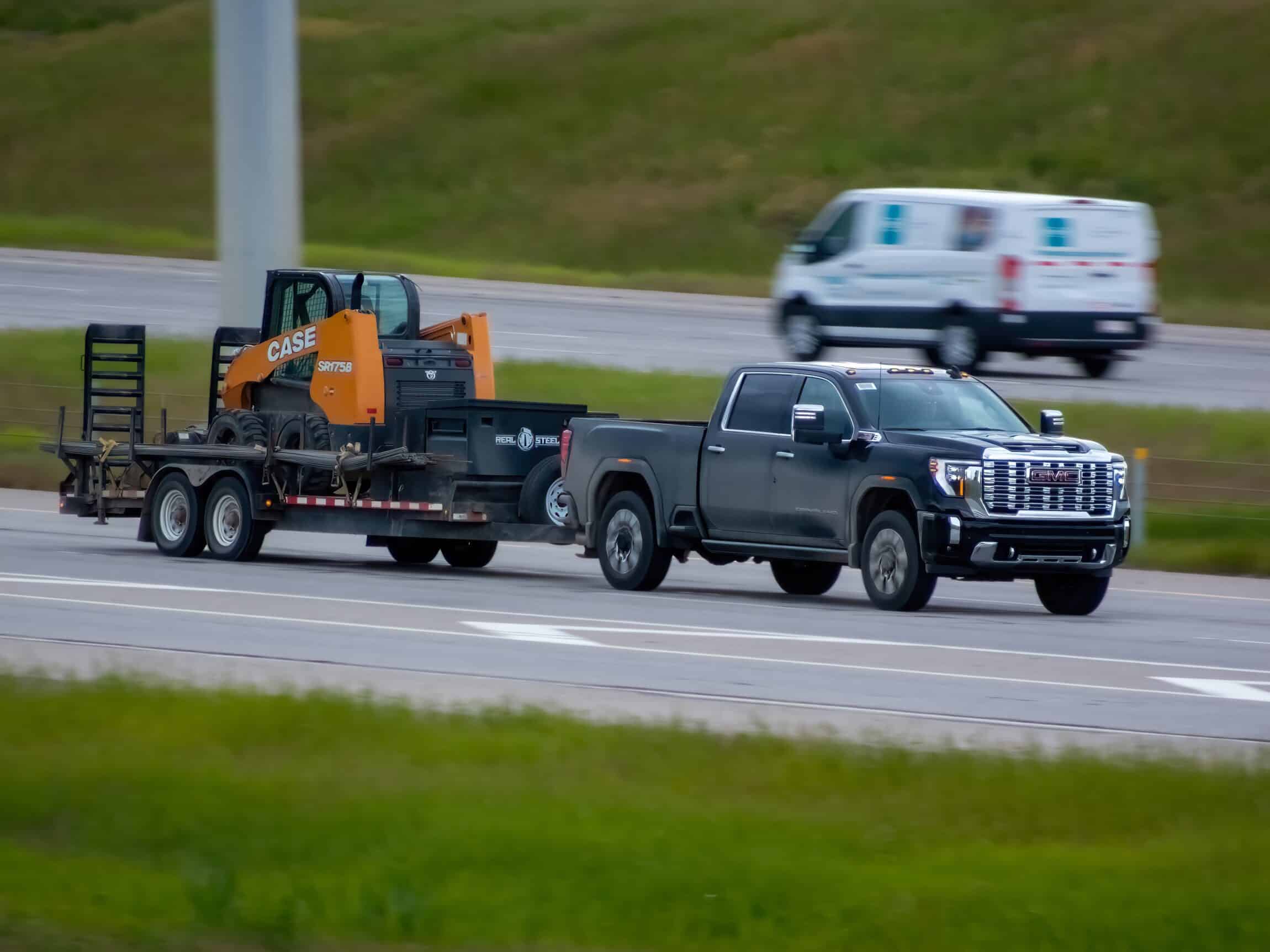
Conclusion
The ELD law in California has been in effect for a while now, and enforcement is now routine for intrastate commercial drivers. With penalties reaching thousands of dollars and established CHP enforcement protocols, choosing a dependable electronic logbook is critical for protecting your business.
The right ELD provider serves as more than just a vendor — they become your compliance partner. A reliable system ensures accurate logging, seamless data transfer during inspections, and ongoing support when you need it most. Poor-quality devices or unreliable providers can leave you stranded with violations, even when you’re trying to follow the rules.
Look for providers that offer proven hardware, comprehensive support, and a track record of keeping drivers compliant. Features like automatic updates, multilingual support, and responsive customer service make the difference between smooth operations and costly headaches. Your ELD choice affects daily operations, so invest in a solution that works consistently.
California’s strict enforcement means there’s no margin for error with unreliable equipment or unresponsive support. Partner with a reliable provider that understands the regulations, supports your compliance efforts, and helps turn the mandate into a tool for safer, more efficient operations. The right choice protects your business while improving your bottom line.
Disclaimer: This guide provides general information about California ELD requirements. Always verify current requirements with the California Highway Patrol and FMCSA, and consult qualified legal counsel for specific compliance questions. This information should not be considered legal advice.

I’ve co-founded, built and managed several transportation-related businesses. Now, I’m a founder and CEO of HOS247 – an AI Transportation Platform for trucking companies, freight brokers and other logistics operations. We are transitioning old-style operations to technology-advanced logistics entities and help them to grow their businesses. ELDs (electronic logging devices), fleet tracking and management 2.0 combined with AI-powered dispatch tools.












Top ELD Providers in the US ELD compliance is a key concern for trucking businesses and everyone is looking for top ELD providers to help them achieve it. There are multiple elogs out there, too many to choose from. To
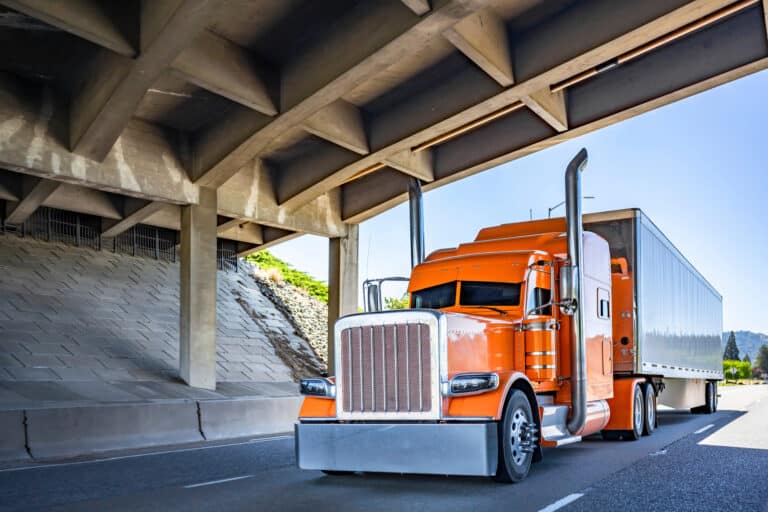
Finding a guaranteed compliant DOT ELD may be challenging in the US. Manufacturers of electronic logging devices certify their own products based on the technical requirements established by FMCSA. Unfortunately, even elogs officially registered in the DOT ELD list may
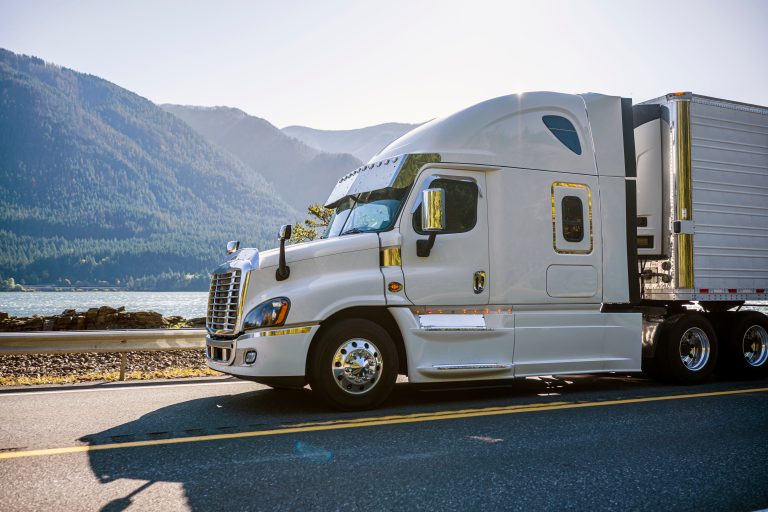
If you manage a fleet or are an owner-operator, then you need to have ELD logs. An ELD (Electronic Logging Device) is mandatory for any commercial truck in the United States territory. But as a truck driver, what happens when
